Tue, Jan 09, 2024
'See & Avoid’ Failure Belies Other Structural Misses in Tour Industry
An Australian helicopter tour crash has been updated with more recent findings, just over a year since the incident took place.

On January 2nd, 2023, a pair of Eurocopter EC120B4 aircraft collided on the Gold Coast of Queensland, killing 4 and injuring 9 passengers. The incident was fairly well documented, thanks to the tourists aboard. While headlines focused on the interim report’s mention of cocaine traces in one of the pilots’ blood, a few other lessons of note arise. The pilot’s positive result was accompanied by no signs of chronic stimulant use, and the drug could have been taken up to 4 days before the accident flight. Given the timeline included in the report, the recent New Year’s holiday makes for a likely ingestion date. It’s “unlikely” that the cocaine would have caused pilot impairment, in any case. So what’s more interesting?
Firstly, the incident appears to be caused by a simple human factors error - poor communications, and pilots relying on assumptions of externalities instead of verifying things for themselves brought the aircraft down that day. Second, the proper and continued use of life jackets for both pax and crew left something to be desired. Footage from passengers showed that a handful of those involved were not wearing their seat belts properly. Only one of the pilots had apparently donned one of their constant-wear lifejackets. The Australian NTSB report makes note that one of the Crewsaver jackets was overdue for an inspection, while the model itself was technically not CASA approved for use.
While investigating, chief commissioner Angus Mitchell brought up a concern of those involved in researching the incident: Those in the air tourism industry, both operators and passengers, may not fully understand how constant-wear life jackets should be worn in conjunction with seat restraints. Some passengers had improperly buckled their own 4-point restraints, and ATSB investigators believe that improved preflight briefings with more clearly defined belt criteria would have helped prevent injury. Worse, Sea World Helicopters’ preflight safety video even illustrates “proper” belt fitment incorrectly, with pax on screen sporting their lap belts across their abdomen. In that case, it could cause additional abdominal injury when the soft, unprotected organs of the abdomen are forced to take the brunt of decelerational forces.
A final report is expected sometime later this year, says Mitchell. “This was a tragic accident, and it is our responsibility to make findings and drive safety actions, which reduce the likelihood of a similar occurrence in the future,.”
More News
Also: Outlaw Prop 4 Mooney, Ready 4 Duty, Ukrainian F-16 Pilot Lost, Blue Origin Flt On his journey to become the first pilot to land solo on all seven continents, 19-year-old Etha>[...]
Also: DarkAero Update, Electric Aircraft Symposium, Updated Instructor Guide, OSH Homebuilts Celebrate The long-awaited Sonex High Wing prototype has flown... the Sonex gang tells >[...]
Discrete Code As used in the Air Traffic Control Radar Beacon System (ATCRBS), any one of the 4096 selectable Mode 3/A aircraft transponder codes except those ending in zero zero; >[...]
From 2023 (YouTube Edition): Deviation from the Historical Mean Racine, Wisconsin-based DeltaHawk is a privately-held manufacturer of reciprocating engines for aircraft and hybrid >[...]
Aero Linx: Formation and Safety Team (F.A.S.T.), USA The Formation and Safety Team (FAST) is a worldwide, educational organization dedicated to teaching safe formation flying in Wa>[...]
 Airborne 07.02.25: TikToker Arrested, Vietnam A/L Ground Hit, ATC Modernization
Airborne 07.02.25: TikToker Arrested, Vietnam A/L Ground Hit, ATC Modernization Airborne Affordable Flyers 07.03.25: Sonex HW, BlackShape Gabriel, PRA Fly-In 25
Airborne Affordable Flyers 07.03.25: Sonex HW, BlackShape Gabriel, PRA Fly-In 25 ANN's Daily Aero-Term (07.07.25): Discrete Code
ANN's Daily Aero-Term (07.07.25): Discrete Code Classic Aero-TV: DeltaHawk Aero Engine Defies Convention
Classic Aero-TV: DeltaHawk Aero Engine Defies Convention ANN's Daily Aero-Linx (07.07.25)
ANN's Daily Aero-Linx (07.07.25)



